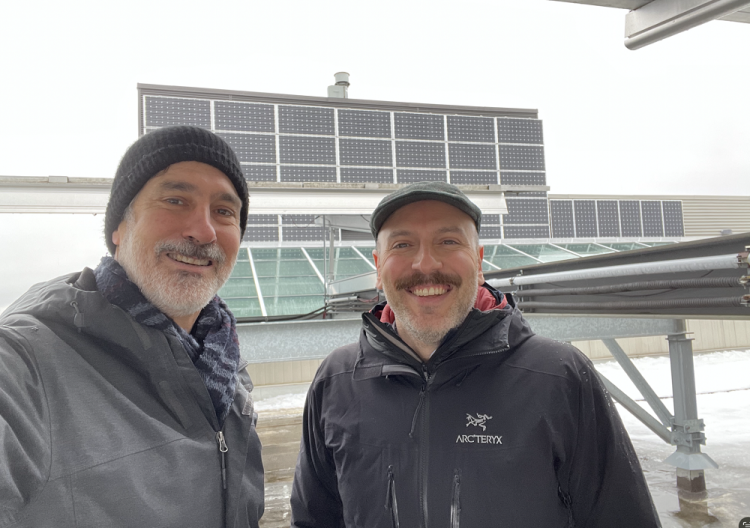Earth Day is recognized annually on April 22. This year's theme, Our Power, Our Planet, invites everyone to unite behind renewable energy, to triple clean electricity by 2030. As people around the world celebrate the planet today and recommit to climate action, we pause to reflect on the ways the University of Waterloo is making advancements to improve energy literacy and conservation on campus.
Since its construction, solar panels have been a key feature of Environment 3 (EV3). When they were installed a decade ago, they produced 67,000 kW-hours per year, roughly the amount to power seven homes. It was one of several features that led to EV3 being recognized as the first LEED® (Leadership in Energy and Environmental Design) Platinum certified building on an Ontario campus.
With support from a Canada Foundation for Innovation grant, additional solar panels and brand-new measurement equipment were installed this past year. It was part of a revitalization project that was overseen by Dr. Paul Parker and Dr. Ian Rowlands in the Faculty of Environment, and Dr. Costa Kapsis in the Faculty of Engineering. Now, this work is bringing fresh research opportunities to benefit both campus and community.
Enhancing energy literacy in our community
With the new measurement equipment up and running, Environment researchers and students are exploring how to use it to enhance energy literacy among EV3 occupants and visitors. A survey conducted by students in the course GEMCC 690: Climate Change Projects is gathering insights on what data might inspire sustainable behaviors. This work is not just theoretical it's paving the way for a planned interactive display in EV3 or a web-based tool that could help building users learn about energy production and consumption patterns.
"Depending on the time of day, the Ontario power grid is more or less carbon intensive," explains Ian Rowlands, professor in the Faculty of Environment. "We are hoping an energy literacy project like this will help our building occupants and visitors think about their usage, like when they plug in their phone or laptop. If they are cognizant of those lower carbon times or solar production times, perhaps it will inform when they plug in."

Dr. Ian Rowlands and Dr. Costa Kapsis beside the original EV3 solar panels.
Enhancing energy efficiency
Where Environment is taking the lead on projects dealing with energy literacy, Engineering is looking at performance. The solar energy system at EV3 includes a decade-old rooftop canopy, an equally aged vertical façade array, and now a brand-new installation featuring bifacial solar panels. Unlike traditional panels, bifacial modules generate electricity not just from sunlight striking the front surface, but also from reflected sunlight that bounces off EV3's white roof and hits the back of the panels, giving them an extra efficiency boost. This unique setup allows researchers to compare the performance of older systems with newer technology under real-world conditions. They're analyzing how the older panels have degraded over time - typically around half to one per cent loss per year - and observing how factors like snow, cloud cover, and seasonal sunlight angles affect electricity generation.
"The façade system often performs better in winter because it's vertical, avoiding snow buildup and capturing low-angle sunlight. These insights help create more accurate models for predicting solar energy production, while also powering parts of the EV3 building. It's a powerful example of how campus infrastructure can support both sustainability and cutting-edge research," Kapsis says.
By tackling both human behavior and improving the technical side of renewable energy, these research teams are advancing the energy transition that our society needs unequivocally. But time is of the essence. In Ontario we are witnessing an increased demand for electricity because of the growth of data centers and AI, the electrification of transportation and heating, but also because of an increased desire to attract new industry to Ontario. It's expected that demand for electricity will grow by 75 per cent over the next 25 years.
"To get a sustainable future, we need an energy transition," says Rowlands. "Sustainable Development Goal 7 points us to how we can achieve that energy transition, which includes renewable energy, but also includes energy efficiency and energy conservation measures, as part of a portfolio approach."
At the University of Waterloo, diversifying our energy supply with renewables is a cornerstone of our sustainability strategy. As we reflect on our power and our planet this Earth Day, this solar panel project serves as a reminder that renewable energy is not just a wise environmental choice - it's an opportunity to innovate, educate and engage communities in shaping a sustainable future.
"Using our roof spaces as sources of low carbon electricity demonstrates to students and community partners that the energy transition is practical as well as possible," the researchers say.












